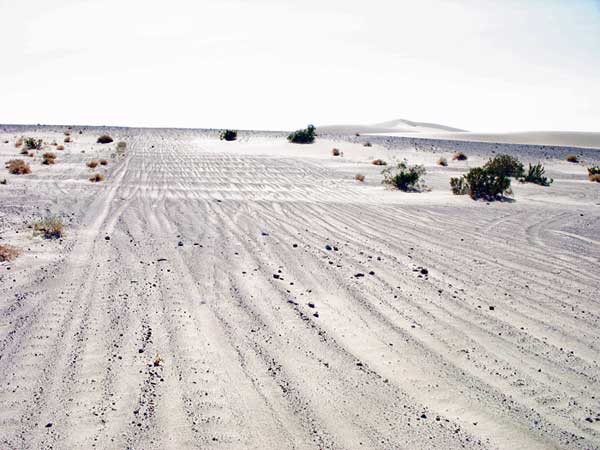Update: Off-Roaders in the Mojave Desert
February 6, 2009 - Pahrump, Nevada
We attended a meeting today of the Bureau of Land Management (BLM) and Mojave-Southern Great Basin Resource Advisory Council, which covered a range of topics affecting public lands in Nevada. Off-highway vehicles was a big one.
As 30 to 40,000 motorcylists, dune-buggy riders, and racing trucks gathered this weekend at Dumont Dunes in California, over the border in Nevada land managers say they are facing "a huge challenge." Mary Jo Rugwell, Southern Nevada district manager for BLM in Las Vegas, said her agency had no real plans for how to handle the recreational riders at places like Big Dune in the Amargosa Valley (Nye County), and the long overland races such as Terrible's Las Vegas to Reno race. They have hired a contractor to help develop recreational management plans.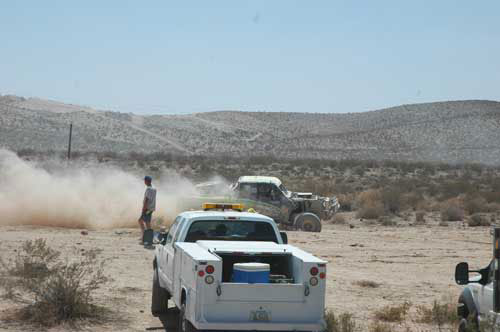
There are many promoters wanting races in the desert, and they do not want to use the same routes every time -- not "challenging enough." Rugwell said the BLM tries to stick with one or a few routes in order to reduce damage, and they want to start to GPS the routes (using satellite global positioning units to map roads accurately). This would help to designate routes in management plans.
"But there's no guaruntee that they will stay on these," Rugwell added. Off-roaders having been growing bolder and less cooperative lately, even around well-signed routes. The increase in resistance is "alarming." Rugwell paused, then added, "and even violent."
"That's really disturbing to me," she said, indicating that the safety of law enforcement officers was in question.
It has not been easy, Rugwell explained, to do a better job on signing and education. This problem has "been running us."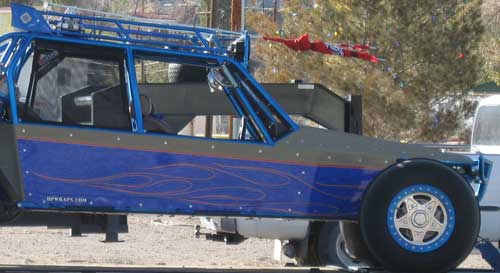
Asked whether having license plates would help, as in other states, Rugwell said probably not. There is a "hell-bent-for-leather" attitude. "They would just as soon hurt us as look at us."
Claire Toomey, council member and long-time Pahrump OHV recreationist did bring up, however, that if there was some identification on motorcycles, they would not be as anonymous. When she tries to talk to them, "they flip you off" and you can't see who you are talking to through the helmet.
John Ruhs, BLM Ely district manager, said these fee and sticker programs do work in other states but in Nevada use is mostly on public lands, which BLM must enforce. In other states it's "everybody's problem." Here it's BLM's problem. And there is no support for such a program from the OHV community.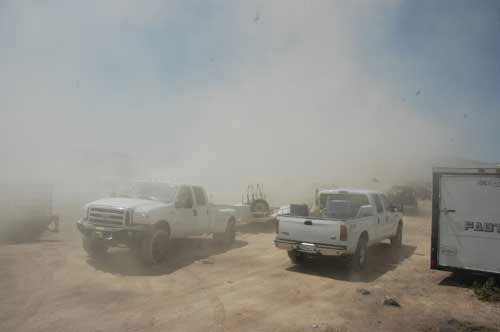
John Hiatt, Las Vegas environmentalist and chair of the Resource Advisory Council, told how the air quality people in Clark County often feel like they've been left out of the loop: Jean Dry Lake (south of Las Vegas) produces an "unbelievable amount of dust" during race days, and if winds are blowing the dust often enters the southern Las Vegas Valley. These are health issues, he said. A constant law enforcement presence is also needed. Hiatt recommended more public relations campaigns. Only 3 to 5% of the population are OHV users, but they have a disproportionate impact on the land. A study done in New Mexico interviewed OHV users, asking them if they would stay on designated routes. 50% said no. "That is why they bought their machine, to go off into the desert. So no amount of signage will help," Hiatt thought. Utah has a growing number of "self-designated trails."
Rugwell agreed, that BLM needs to partner with Clark County air quality to expand their educational program. They have given money to the National Park Service to visit high school drivers ed programs and give presentations to kids about the right way to use OHVs. "It's a behavior problem."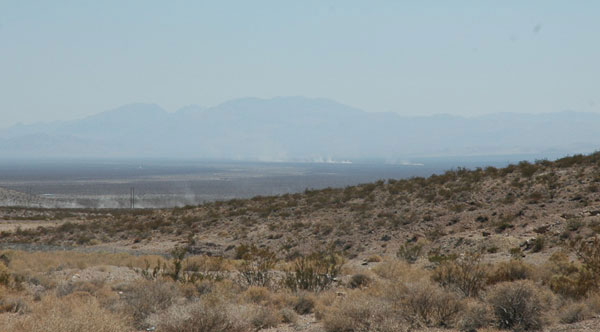
Brian Brown of the Amargosa Conservancy, noted that there has been more incursion into the Nopah Wilderness. He believed it might help to have a green sticker program as in nearby Dumont Dunes in California, as well as better maps to show where boundaries were.
^The 2007 Reno to Las Vegas Race in the Amargosa Desert.
Rugwell agreed, but pointed out that at up the valley at Big Dune in Nevada, since there are no charges for use there (because there are no facilities), everyone goes to Big Dune from everywhere else that does charge.
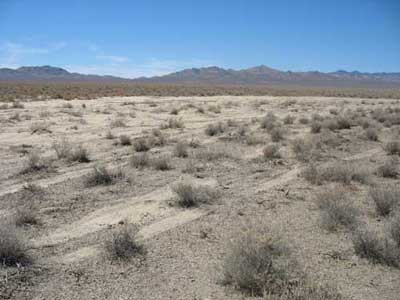
Hiatt added, that if BLM started charging at Big Dune, OHVs would just go somewhere else again. He said we need across-the-board rules for very large areas, states, to protect resources. There is at least as much damage from casual routes as from big events. It's onging. Soil is being lost. The OHV community needs to understand that abuse will bring increased regulations. "We need to get the message out: tone it down and you can keep some freedom. The general public needs to know."
Toomey was trying to get people to avoid pushing into every area of the Wheeler Wash wildlife corridor in the Spring Range next to Pahrump, home to a diverse pine forest and Gambel oak (Quercus gambelii) scrub above the desert basins, including the rare Clokey's Egg-vetch (Astragalus oophorus var. clokeyanus). She was working with both the Las Vegas Pauite Tribe on the east side of the mountain pass corridor, and Toiyabe National Forest to make a west side management plan. The Forest Service admitted it was behind on route and recreation trail mapping, and was trying to make a renewed effort. The canyon forest is also home to Goshawks (Accipiter gentilis), Flammulated owls (Otus flammeolus), Mule deer (Odocoileus hemionus), and Palmer's chipmunks (Tamias palmeri). 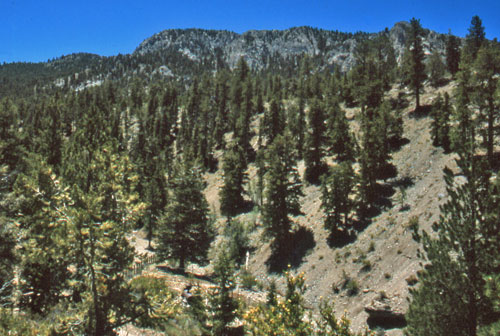
Hiatt observed that you can get the OHV community to help build trails, but could not get them to help preserve wildlife and lands. Even truck ads on TV show people blasting through streams, with "high speed and thrills."
Ed Higbee, representing ranchers in the council, said OHVs also go on grazer's lands, demolishing roads, not fixing them for long periods.
^Wheeler Canyon in the Spring Range.
Nye County Commissioner Joni Eastley brought up how the county makes the promoter of the Terrible's Vegas to Reno Race bond to repair roads. Separate fees are collected to get ready for the race, put law enforcement out there, and protect the public from the race. But she admitted that sometimes so much damage is done to roads that "you can't do much." Eastley asked if BLM could try to limit the number of races? Someone else asked if BLM could hold the permit if the promoter did not reclaim the roads?
Rugwell said that Clark County has tried to limit races in the Las Vegas area, but then "lots of phone calls are made and lots of pressure put on, and it gets political." The OHV community has a lot of money and a lot of poltical support. "They are very well connected." She told us how last fall "we had a race that went very badly," [we beleive she was referring to the ‘Silver State 300’ race from Alamo to Mesquite in eastern nevada]. "I guy said to me it's his God-given right to do this, and we had no right to regulate it. There are rogue OHVers."
But this is our public land, it has rules of multiple use.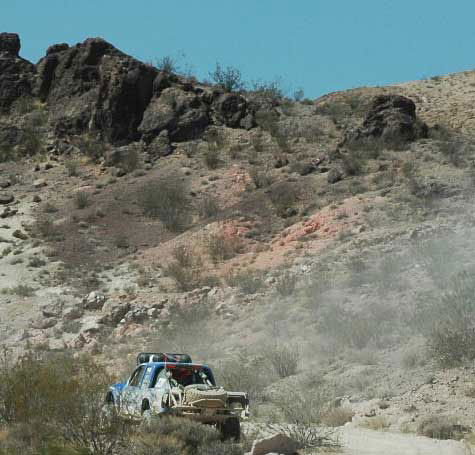
Rugwell also pointed out that there will be more multiple use conflicts coming up, such as the planned new airport at Ivanpah Dry Lake, as well as the numerous solar power plant companies applying for land leases. Large clouds of dust from OHV races will not be tolerated next to airports, nor dust falling down onto glass mirrors or photovoltaic plates that need to be clean to maximize their efficiency.
Other issues also came up. We pointed out that private property rights should also be considered in any future planning. Council member Douglas "Stretch" Baker noted that fans of the races can also dump trash, empty their holding tanks in the desert, and drive around recklessly too.
Eastley said that in Nye County, pre- and post-race inspections, although they take time, have helped these problems; "They can't say they didn't know." Tom Seley (BLM Tonopah district) said that the promoter of the Terrible's Vegas to Reno Race pays for road maintenance, although the counties may not schedule reclamation for several months due to other priorities. But the race has been improved the past year because of the reviews. And the racers will be required to use more of the same routes.
New Tactics Needed for OHV Recreation
Thr council group agreed that BLM should look into the possibility of bonding the OHV users in a cost-recovery program that would include pre-condition and post-condition tours of the race routes. They also suggested that a more consistent process and message should be decided upon by the three BLM districts invloved in race issues (Las Vegas, Tonopah, and Ely), to try to reduce the amount of political play. "We need standardization," said Hiatt.
Comments? Sign our GUEST BOOK>>![]()
HOME.........Terrible's Vegas to Reno Race..........Amargosa Desert.....Conflicting Use with Solar
